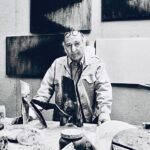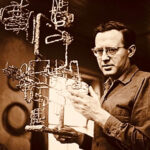David Smith
David Smith (1906-1965) is celebrated as one of the most influential American sculptors of the 20th century. His innovative approach to sculpture, marked by his mastery of welding and his unique use of industrial materials, helped redefine the medium and cement his legacy as a pioneer in modern art.

Early Life and Education
David Roland Smith was born on March 9, 1906, in Decatur, Indiana. Raised in a modest family, Smith’s early life was marked by a blend of rural and industrial influences. His father worked as a telephone engineer, and his mother was a schoolteacher. These early experiences in a working-class environment would later inform his artistic sensibilities and his choice of materials.
In 1925, Smith enrolled at Ohio University in Athens, Ohio, but soon transferred to Notre Dame in Indiana. However, his formal education was short-lived; he left Notre Dame after a year and moved to New York City. There, he attended the Art Students League, where he studied painting and drawing under the guidance of influential artists like Jan Matulka and John Sloan. Matulka, in particular, introduced Smith to the works of European modernists, including Pablo Picasso and Russian Constructivists, which had a profound impact on his development as an artist.
Transition to Sculpture
Although Smith initially pursued painting, his interest in sculpture was piqued by his exposure to the works of Julio González and Pablo Picasso, both of whom used welding techniques to create metal sculptures. By the early 1930s, Smith began experimenting with sculpture, using found objects and industrial materials.
Smith’s background in industrial work—he had worked briefly as a riveter and welder in an automobile factory—gave him the skills and confidence to explore welding as a sculptural technique. He began creating abstract forms out of metal, integrating his knowledge of Cubism and Constructivism with his newfound medium.
Artistic Evolution and Major Works
Throughout his career, Smith’s work evolved through several distinct phases, each characterized by his innovative use of materials and forms. His sculptures often combined geometric abstraction with organic shapes, creating dynamic compositions that defied traditional sculptural conventions.
- “Cubi” Series (1961-1965)One of Smith’s most famous series, the “Cubi” works are monumental stainless steel sculptures composed of cubic and cylindrical shapes. These pieces are celebrated for their polished surfaces and the way they interact with light, creating a sense of movement and fluidity. The “Cubi” series exemplifies Smith’s mastery of welding and his ability to transform industrial materials into refined, abstract forms. Notable Artwork: “Cubi XXVIII” (1965)“Cubi XXVIII” is a striking example from this series, characterized by its balanced composition and reflective surface. The sculpture stands over nine feet tall and is composed of stacked and balanced geometric shapes. The interplay of light and shadow on the polished metal surface creates a dynamic visual experience, emphasizing the sculpture’s abstract form and the artist’s technical prowess.
- “Tanktotem” Series (1952-1960)The “Tanktotem” series marks another significant phase in Smith’s career. These sculptures are constructed from found industrial objects, such as tank ends, pipes, and steel beams, arranged into totemic forms. The “Tanktotem” works reflect Smith’s interest in primitive art and his ability to transform discarded materials into powerful, evocative sculptures. Notable Artwork: “Tanktotem IV” (1953)“Tanktotem IV” is an iconic piece from this series, standing over ten feet tall and composed of welded steel and found industrial objects. The sculpture’s vertical, totemic form and its raw, industrial aesthetic demonstrate Smith’s innovative approach to sculpture and his ability to imbue industrial materials with symbolic meaning and emotional resonance.
- “Agricola” Series (1950-1957)The “Agricola” series showcases Smith’s ability to blend abstraction with references to agricultural tools and machinery. These sculptures are composed of welded steel parts, often incorporating recognizable elements such as plowshares, ax heads, and other farm implements. The “Agricola” works highlight Smith’s connection to his rural roots and his interest in the intersection of art and industry. Notable Artwork: “Agricola I” (1951)“Agricola I” is a seminal piece from this series, characterized by its use of agricultural tools and abstract forms. The sculpture’s rugged, industrial aesthetic and its reference to rural life exemplify Smith’s unique artistic vision and his ability to create powerful, evocative works from everyday materials.
Legacy and Influence
David Smith’s innovative approach to sculpture and his mastery of welding and industrial materials have left an indelible mark on the art world. His work paved the way for subsequent generations of sculptors, influencing movements such as Minimalism and Post-Minimalism. Artists like Richard Serra, Anthony Caro, and Mark di Suvero have cited Smith as a major influence on their work.
Smith’s sculptures are held in major museum collections around the world, including the Museum of Modern Art in New York, the National Gallery of Art in Washington, D.C., and the Tate Gallery in London. His legacy is also preserved through the continued work of the David Smith Estate, which manages his extensive body of work and promotes his contributions to modern art.
Personal Life and Tragic End
David Smith’s personal life was as dynamic and complex as his artistic career. He was married twice, first to Dorothy Dehner, an artist and fellow student at the Art Students League, and later to Jean Freas, with whom he had two daughters. Smith’s relationships were often tumultuous, marked by his intense personality and his unwavering commitment to his art.
Tragically, Smith’s life was cut short in 1965 when he died in a car accident near his home in Bolton Landing, New York. Despite his untimely death, Smith’s impact on the art world remains profound, and his innovative approach to sculpture continues to inspire and challenge artists and audiences alike.
Conclusion
David Smith’s contributions to modern sculpture cannot be overstated. His innovative use of welding and industrial materials, combined with his unique artistic vision, helped redefine the boundaries of sculpture and establish him as one of the foremost artists of the 20th century. Through his seminal works in the “Cubi,” “Tanktotem,” and “Agricola” series, Smith demonstrated his ability to transform everyday materials into powerful, abstract forms that continue to captivate and inspire. His legacy endures through his influential body of work and the lasting impact he has had on the world of modern art.



